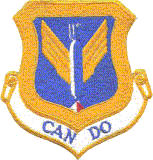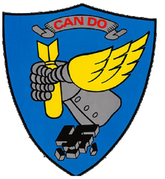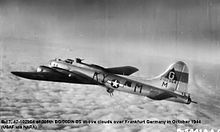305th Operations Group
This article includes a list of general references, but it lacks sufficient corresponding inline citations. (March 2017) |
| 305th Operations Group | |
|---|---|
Air Force Outstanding Unit Award[2] | |
| Commanders | |
| Notable commanders | Curtis LeMay |
| Insignia | |
| 305 Operations Gp emblem[2][note 1] |  |
| 305th Bombardment Group emblem (approved 23 April 1951)[1] |  |
| 305th Bombardment Group emblem (World War II)[3] |  |
The 305th Operations Group is a
During World War II, the group's predecessor unit, the 305th Bombardment Group was one of the first
While commanded by Colonel Curtis LeMay the 305th Bomb Group pioneered many bomber flying formations and bombing procedures that became the standard operating procedures in the Eighth Air Force.
The group lost thirteen aircraft during the 14 October 1943 Schweinfurt mission, the heaviest loss of any group on the mission, and for this reason was given a Nazi flag found flying in the city as a war trophy when it was captured by U.S. troops in April 1945.
Overview
The mission of the 305th Operations Group is to deploy worldwide from Air Mobility Command's Eastern Gateway, Joint Base McGuire-Dix-Lakehurst (JB MDL), to perform aerial-refueling and airlift missions, in support of tactical, strategic, reconnaissance, transport, and bombardment forces in high-threat and chemical-warfare environments.
The group flies the
Components
The group comprises the following squadrons:
- 2d Air Refueling Squadron(KC-46)
- The 2nd ARS provides the United States with the Global Reach necessary to support our national security objectives, while placing an increased emphasis on squadron members' families-the unsung heroes of the unit's successful operations.
- 6th Airlift Squadron (C-17)
- The 6th Airlift Squadron is the oldest airlift squadron in the Air Force, having served with distinction since 1 October 1933.
- 32d Air Refueling Squadron(KC-10)
- The 32nd ARS can generate, mobilize and deploy KC-10 aircraft with more than 180 aircrew, maintenance and support people to fulfill a wide variety of worldwide mobility taskings.
- 305th Operations Support Squadron
- The mission of the 305th OSS is to provide information, support, and equipment to allow aircrews to accomplish their global mobility mission.
History
- For additional history and lineage, see 305th Air Mobility Wing
World War II


The 305th Bombardment Group was activated 1 March 1942 at
The ground unit went by train to at
The 305th Bomb Group deployed to England in September 1942 and formed at RAF Grafton Underwood as part of VIII Bomber Command's 40th Bombardment Wing. Was assigned group tail code "Triangle-G". From Grafton Underwood, the group began combat on 17 November 1942 and attacked such targets as submarine pens, docks, harbours, shipyards, motor works, and marshalling yards in France, Germany, and the Low Countries. During December 1942, the group was transferred to RAF Chelveston.
On 27 January 1943, the group participated in the Eighth Air Force's first raid on Germany. During the winter of 1942–1943, the 305th was commanded by Colonel Curtis LeMay and pioneered many of the techniques of daylight bombing used by the USAAF over Nazi-controlled Europe.
The 305th Bomb Group bombed the navy yards at Wilhelmshaven on 27 January 1943 when heavy bombers of Eighth Air Force made their first penetration into Germany. Through mid-1943, the group attacked strategic targets such as submarine pens, docks, harbors, shipyards, motor works, and marshaling yards in France, Germany, and the Low Countries.
The 305th received the
During the second half of 1943, the unit began deeper penetration into enemy territory to strike heavy industry. Significant objectives included aluminum, magnesium, and nitrate works in Norway, industries in Berlin, oil plants at Merseburg, aircraft factories at Anklam, shipping at Gdynia, and ball-bearing works at Schweinfurt.
A second Distinguished Unit Citation was awarded to the 305th for withstanding severe opposition to bombing aircraft factories in central Germany on 11 January 1944. The unit participated in the intensive campaign of heavy bombers against the German aircraft industry during "Big Week," 20–25 February 1944.
In addition to bombardment of strategic targets, the 305th Bomb Group often flew tactical interdictory missions and supported infantry units. Prior to the Normandy invasion in June 1944, it helped to neutralize enemy installations such as V-weapon sites, airfields, and repair shops. On
After "Victory in Europe Day" (
Cold War
Not operational from 16 October to 25 December 1946. During two periods of activation (between July 1947 and September 1948, and, between January 1951 and June 1952), the group was manned only from 2 January to 9 February 1951 when SAC reorganized its wings into the dual deputate system.
Reactivation
On 1 September 1991, the 305th Operations Group activated under the "Objective Wing" concept adapted by the Air Force as the lines between tactical and strategic forces blurred. The flying components of the 305th Air Refueling Wing were reassigned to the newly established group.
The
The 305th was reactivated at McGuire Air Force Base, New Jersey, replacing the
Lineage
- Established as 305th Bombardment Group (Heavy) on 28 January 1942
- Activated on 1 March 1942
- Redesignated 305th Bombardment Group, Heavy on 20 August 1943
- Inactivated on 25 December 1946
- Redesignated 305th Bombardment Group, Very Heavy on 11 June 1947
- Activated on 1 July 1947
- Inactivated on 6 September 1948
- Redesignated 305th Bombardment Group, Medium on 20 December 1950
- Activated on 2 January 1951
- Inactivated on 16 June 1952
- Redesignated 305th Operations Group on 29 August 1991
- Activated on 1 September 1991
- Inactivated on 15 October 1993
- Activated on 1 October 1994[2]
Assignments
|
|
Components
- 2d Air Refueling Squadron: 1 July 1995 – present
- 6th Airlift Squadron: 1 October 1994 – present
- 13th Airlift Squadron: 1 October 1994 – 31 March 2000
- 18th Airlift Squadron: 1 October 1994 – 1 July 1995
- 32d Air Refueling Squadron: 1 July 1995 – present
- 33d Reconnaissance Squadron (later 422d Bombardment Squadron): 1 March 1942 – 25 December 1946
- 46th Air Refueling Squadron: 1 June 1992 – 8 October 1993
- 70th Air Refueling Squadron: 1 September 1991 – 1 April 1993
- 305th Air Refueling Squadron: 2 July 1951 – 16 June 1952 (attached to 305th Bombardment Wing); 1 September 1991 – 20 August 1993
- 305th Operations Support Squadron, 1 September 1991 – 15 October 1993, 1 October 1994 – present
- 364th Bombardment Squadron: 1 March 1942 – 29 June 1946; 1 July 1947 – 6 September 1948; 2 January 1951 – 16 June 1952 (attached to 305th Bombardment Wing after 10 February 1951)
- 365th Bombardment Squadron: 1 March 1942 – 31 October 1946; 1 July 1947 – 6 September 1948; 2 January 1951 – 16 June 1952 (attached to 305th Bombardment Wing after 10 February 1951)
- 366th Bombardment Squadron: 1 March 1942 – 25 December 1946; 1 July 1947 – 6 September 1948; 2 January 1951 – 16 June 1952 (attached to 305th Bombardment Wing after 10 February 1951)
- 422nd Bombardment Squadron: attached 16 July – 25 December 1946
- 905th Air Refueling Squadron: 1 June 1992 – 1 July 1993
- 920th Air Refueling Squadron: 1 June – 30 September 1992[2]
Stations
|
|
Aircraft assigned
|
|
References
- Notes
- ^ The group uses the 305th Air Mobility Wing emblem with the group designation on the scroll. Kane, Factsheet, 305 Operations Group.
- ^ Aircraft is Boeing B-17F-115-BO Flying Fortress serial 42-30647. On 23 September 1943, this aircraft crashed at Chevelston returning from a mission, killing all on board.
- Kingman Army Air FieldArizona on 4 December 1945 for storage.
- Citations
Bibliography
![]() This article incorporates public domain material from the Air Force Historical Research Agency
This article incorporates public domain material from the Air Force Historical Research Agency
- Anderson, Capt. Barry (1985). Army Air Forces Stations: A Guide to the Stations Where U.S. Army Air Forces Personnel Served in the United Kingdom During World War II (PDF). Maxwell AFB, AL: Research Division, USAF Historical Research Center. Archived from the original (PDF) on 23 January 2016. Retrieved 7 July 2012.
- Freeman, Roger A. (1978) Airfields of the Eighth: Then and Now. After the Battle ISBN 0-900913-09-6
- Freeman, Roger A. (1991) The Mighty Eighth The Colour Record. Cassell & Co. ISBN 0-304-35708-1
- Johnson, 1st Lt. David C. (1988). U.S. Army Air Forces Continental Airfields (ETO) D-Day to V-E Day (PDF). Maxwell AFB, AL: Research Division, USAF Historical Research Center. Archived from the original (PDF) on 29 September 2015.
{{cite book}}: CS1 maint: numeric names: authors list (link) - Maurer, Maurer, ed. (1983) [1961]. Air Force Combat Units of World War II (PDF) (reprint ed.). Washington, DC: Office of Air Force History. LCCN 61060979. Retrieved 17 December 2016.
- Maurer, Maurer, ed. (1982) [1969]. Combat Squadrons of the Air Force, World War II (PDF) (reprint ed.). Washington, DC: Office of Air Force History. OCLC 72556. Retrieved 17 December 2016.
- Ravenstein, Charles A. (1984). Air Force Combat Wings, Lineage & Honors Histories 1947–1977. Washington, DC: Office of Air Force History. ISBN 0-912799-12-9. Retrieved 17 December 2016.
- Rogers, Brian. (2005). United States Air Force Unit Designations Since 1978. Hinkley, UK: Midland Publications. ISBN 1-85780-197-0.
External links
- Joint Base McGuire-Dix-Lakehurst (Official Web site)
- Air Mobility Command (Official Web site)
- USAAS-USAAC-USAAF-USAF Aircraft Serial Numbers—1908 to present


